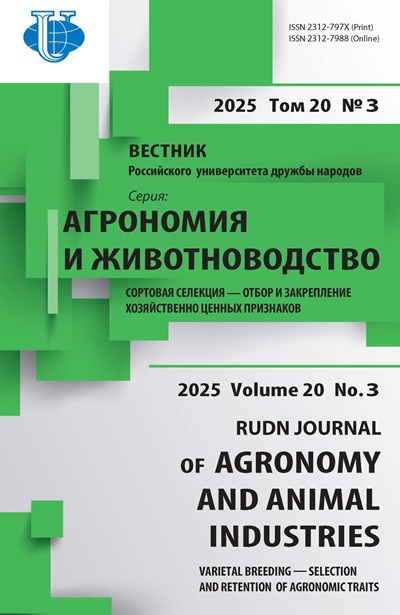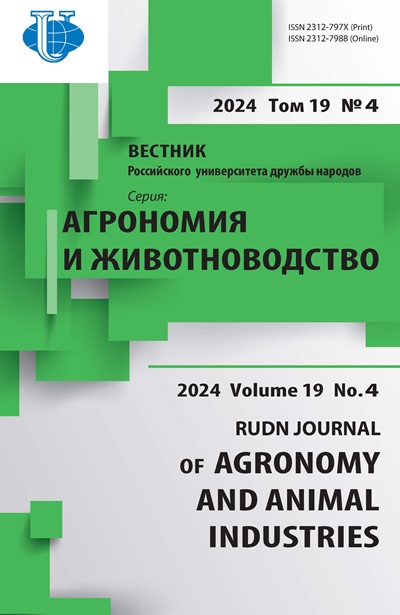Comparison of hematological blood parameters when studying chronic toxicity of Protigen feed additive
- Authors: Sabirzyanova L.I.1
-
Affiliations:
- Saint Petersburg State University of Veterinary Medicine
- Issue: Vol 19, No 4 (2024)
- Pages: 659-668
- Section: Animal breeding
- URL: https://agrojournal.rudn.ru/agronomy/article/view/20132
- DOI: https://doi.org/10.22363/2312-797X-2024-19-4-659-668
- EDN: https://elibrary.ru/CDXASP
- ID: 20132
Cite item
Full Text
Abstract
Urea as a feed additive can be used in ruminant diets to provide degradable protein in the rumen. Its economic value justifies interest in using this additive as a partial replacement for plant protein sources. Urea processing in the rumen has some peculiarities: rapid hydrolysis to ammonia exceeding the rate of carbohydrate fermentation in the rumen and, consequently, a decrease in the efficiency of microbial crude protein synthesis, and an increase in the risk of ammonia toxicity as the result of increase in the concentration of ammonia in the blood. Therefore, there is a need for preliminary processing of this feed additive, for example using coating technology to develop sustained release urea products that could control urea degradation and ammonia release into the rumen. Protigen feed additive is an innovative ingredient that provides slow release of non-protein nitrogen in the rumen. Its large-scale implementation in animal diets requires additional research on biological effects of using this feed additive. Thus, the purpose of our research was to study the effect of Protigen feed additive on some hematological parameters of rats. The object of the research was 50 outbred rats (♀) weighing 190—210 grams. Based on the results of previous studies, the first experimental group received the feed additive at a dose of 1/5 of the maximum tolerated (1000 mg/kg body weight), the second — 1/10 of the maximum tolerated (500 mg/kg body weight), the third (control) group did not receive the feed additive. The values of hematological parameters in laboratory animals were recorded after 90 days of daily feeding of the feed additive (91 days of the experiment) and 10 days after discontinuation of the drug (101 days of the experiment). When studying biological effects of using Protigen feed additive on hematological parameters of rats, no statistically significant differences were found compared to the control group.
Full Text
Table 1
Effect of Protigen feed additive on hematological parameters of rats in experimental group 1 and control group on the 91st and 101st day of the experiment
Indicator | 91 days | 101 days | ||||
Group 1 (n = 10) | Control group (n = 5) | P | Group 1 (n = 10) | Control group (n = 5) | P | |
M ± SEM | M ± SEM | M ± SEM | M ± SEM | |||
Hematocrit, l/l | 54.4 ± 1.8 | 53.0 ± 1.2 | 0.4005 | 54.4 ± 1.7 | 54.8 ± 1.0 | 0.9155 |
Hemoglobin, g/l | 103.8 ± 2.3 | 117.0 ± 3.0 | 0.2219 | 108.6 ± 4.0 | 113.6 ± 4.3 | 0.1732 |
Leukocytes, 109/l | 11.6 ± 0.6 | 9.1 ± 1.4 | 0.2101 | 12.1 ± 1.3 | 12.3 ± 1.6 | 1.0 |
Lymphocytes, % | 69.0 ± 2.2 | 72.0 ± 3.8 | 0.9166 | 69.0 ± 5.4 | 63.8 ± 2.2 | 0.1732 |
Monocytes, % | 2.8 ± 0.6 | 2.4 ± 0.6 | 0.6644 | 1.4 ± 0.6 | 4.0 ± 0.5 | 0.2289 |
Band neutrophils, % | 1.8 ± 0.5 | 0.8 ± 0.4 | 0.1544 | 1.4 ± 0.2 | 0.8 ± 0.6 | 0.2282 |
Segmented neutrophils, % | 26.0 ± 2.2 | 24.6 ± 3.7 | 0.9163 | 27.4 ± 4.9 | 28.0 ± 2.4 | 0.5309 |
ESR, mm/h | 0.5 ± 0.0 | 0.5 ± 0.0 | 0.8808 | 0.4 ± 0.0 | 0.4 ± 0.0 | 0.4189 |
Thrombocytes, 109/l | 211.0 ± 10.8 | 188.0 ± 10.3 | 0.2073 | 179.2 ± 8.4 | 210.4 ± 18.4 | 0.1161 |
Eosinophils, % | 0.4 ± 0.2 | 0.2 ± 0.2 | 0.6005 | 0.8 ± 0.5 | 0.4 ± 0.2 | 0.722 |
Erythrocytes, 1012/l | 8.4 ± 0.9 | 6.6 ± 0.2 | 0.1437 | 7.0 ± 0.8 | 6.6 ± 0.1 | 0.8345 |
Source: completed by L.I. Sabirzyanova.
Table 2
Effect of Protigen feed additive on hematological parameters of rats in experimental group 2 and control group on 91st and 101st day of the experiment
Indicator | 91 days | 101 days | ||||
Group 1 (n = 10) | Control group (n = 5) | P | Group 1 (n = 10) | Control group (n = 5) | P | |
M ± SEM | M ± SEM | M ± SEM | M ± SEM | |||
Hematocrit, l/l | 55.2 ± 1.6 | 53.0 ± 1.2 | 0.2477 | 52.8 ± 0.6 | 54.8 ± 1.0 | 0.0867 |
Hemoglobin, g/l | 111.4 ± 3.7 | 117.0 ± 3.0 | 0.2492 | 118.6 ± 1.0 | 113.6 ± 4.3 | 0.2918 |
Leukocytes, 109/l | 11.9 ± 0.8 | 9.1 ± 1.4 | 0.2101 | 11.5 ± 1.6 | 12.3 ± 1.6 | 0.402 |
Lymphocytes, % | 64.2 ± 3.5 | 72.0 ± 3.8 | 0.1732 | 66.2 ± 8.3 | 63.8 ± 2.2 | 0.2101 |
Monocytes, % | 3.4 ± 1.2 | 2.4 ± 0.6 | 0.8271 | 3.8 ± 1.2 | 4.0 ± 0.5 | 0.6623 |
Band neutrophils, % | 1.8 ± 0.4 | 0.8 ± 0.4 | 0.1251 | 1.2 ± 0.6 | 0.8 ± 0.6 | 0.6536 |
Segmented neutrophils, % | 30.4 ± 2.6 | 24.6 ± 3.7 | 0.2463 | 28.6 ± 6.8 | 28.0 ± 2.4 | 0.4633 |
ESR, mm/h | 0.4 ± 0.0 | 0.5 ± 0.0 | 0.6005 | 0.4 ± 0.0 | 0.4 ± 0.0 | 0.6312 |
Thrombocytes, 109/l | 226.4 ± 10.3 | 188.0 ± 10.3 | 0.0749 | 182.0 ± 15.2 | 210.4 ± 18.4 | 0.2477 |
Eosinophils, % | 0.2 ± 0.2 | 0.2 ± 0.2 | 0.8808 | 52.8 ± 0.6 | 54.8 ± 1.0 | 0.0867 |
Erythrocytes, 1012/l | 6.5 ± 0.2 | 6.6 ± 0.2 | 0.8335 | 118.6 ± 1.0 | 113.6 ± 4.3 | 0.2918 |
Source: completed by L.I. Sabirzyanova.
About the authors
Lilia I. Sabirzyanova
Saint Petersburg State University of Veterinary Medicine
Author for correspondence.
Email: l-sabirzyanova@list.ru
ORCID iD: 0000-0001-6516-8857
SPIN-code: 3019-3782
Candidate of Veterinary Sciences
5 Chernigovskaya st., Saint Petersburg, 196084, Russian FederationReferences
- Kertz AF. Urea feeding to dairy cattle: a historical perspective and review. The Professional Animal Scientist. 2010;26(3):257—272.
- Technologies for the application of urea in the feeding of ruminants: materials of the VII International Scientific and Practical Conference «Modern Achievements of Biotechnology. Technique», St. Petersburg, 2020. Available at: https://ncfu.ru/upload/MainSKFU/science/ISTD‑19-14-2020.pdf Accessed January 23, 2025. (In Rus.).
- Salami SA, Moran KA, Warren HE, Taylor-Pickard D. Meta-analysis and sustainability of feeding slow-release urea in dairy production. PLoS One. 2021;16(2): e0246922. doi: 10.1371/journal.pone.0246922
- Zhuravlev M, Istomin A. Protected urea in feeds for cows. Nashe sel’skoe khozyaistvo. 2021;(14):16—19. (In Russ.).
- Vandoni S. The role of rumen-degradable protein in cow feeding. Moloko i ferma. 2021;(3). (In Russ.).
- Calsamiglia S, Ferret A, Reynolds CK, Kristensen NB, Van Vuuren AM. Strategies for optimizing nitrogen utilization in ruminants. Animal. 2010;4(7):1184—1196. doi: 10.1017/S1751731110000911
- Owens FN, Qi S, Sapienza DA. Invited review: Applied protein nutrition in ruminants — current status and future directions. The Professional Animal Scientist. 2014;30(2):150—179. doi: 10.15232/S1080-7446 (15) 30102-9
- Ivanov SA, Petrov VB. Influence of synchronization of carbohydrate and nitrogen component degradation in the rumen on metabolism and productivity in ruminants. Problems of Productive Animal Biology. 2019;2:45—53. (In Russ.).
- Naumov AA. The use of Optigen II feed additive in the diets of highly productive dairy cows. In: Agro-industrial complex: state, problems, prospects: conference proceedings. Penza; 2021. p.89—91. (In Russ.).
- Ivanova OV, Ivanov EA, Filipiev MM. The blood biochemical indicators and the cow productivity under the influence of the combined feed additive. Bulletin of KSAU. 2015;(6):215—219. (In Russ.).
- Faizrakhmanov RN, Shakirov SK. Feed additives influence of on the microelement composition of the blood of cows. Journal scientific notes Kazan Bauman state academy of veterinary medicine. 2015;222(2):226—229. (In Russ.).
- Sabirzyanova LI, Tuvardzhiev AV, Konoplev VA. Study of the toxicological properties of the feed additive «Protigen» in laboratory animals. In: Veterinarnaya laboratornaya praktika: conference proceedings. Saint Petersburg; 2024. p.89—94. (In Russ.).
- Sabirzyanova LI. Dynamics of the body weight gain in rats after oral administration of feed additive «Protigen». Vestnik of Buryat state academy of agriculture named after V. Philippov. 2024;1(74):170—174. (In Russ.). doi: 10.34655/bgsha.2024.74.1.021
- Sabirzyanova LI. Conducting preclinical studies of a feed additive with protected non-protein nitrogen. In: Integration of education, science, and practice in the agrarian complex: conference proceedings. Lugansk; 2023. p.82—84. (In Russ.).
Supplementary files















